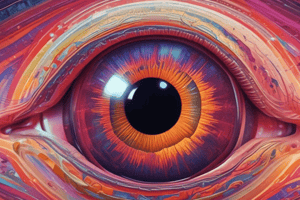Podcast
Questions and Answers
What is multispectral remote sensing primarily used for?
What is multispectral remote sensing primarily used for?
- Visualizing data that is only visible to the human eye
- Collecting energy from multiple bands of the electromagnetic spectrum (correct)
- Restricting data collection to a single band
- Collecting energy reflected only in visible bands
Which type of remote sensing sensor is an example of an across track method?
Which type of remote sensing sensor is an example of an across track method?
- Pushbroom sensors
- Whiskbroom sensors (correct)
- Landsat sensors
- Scanning mirror detectors
Which of the following is NOT a key consideration in multispectral remote sensing resolution?
Which of the following is NOT a key consideration in multispectral remote sensing resolution?
- Radiometric resolution
- Temporal resolution
- Spatial resolution
- Chemical resolution (correct)
What does multispectral remote sensing enable researchers to visualize?
What does multispectral remote sensing enable researchers to visualize?
Which sensor type is associated with along track (pushbroom) scanning?
Which sensor type is associated with along track (pushbroom) scanning?
What does the Instantaneous Field of View (IFOV) determine in whiskbroom systems?
What does the Instantaneous Field of View (IFOV) determine in whiskbroom systems?
In pushbroom imaging systems, which component directly captures reflected radiance onto the detectors?
In pushbroom imaging systems, which component directly captures reflected radiance onto the detectors?
Which of the following accurately describes a disadvantage of whiskbroom systems compared to pushbroom systems?
Which of the following accurately describes a disadvantage of whiskbroom systems compared to pushbroom systems?
What is the primary goal of image classification in remote sensing?
What is the primary goal of image classification in remote sensing?
In unsupervised classification, what initial process is typically employed?
In unsupervised classification, what initial process is typically employed?
Which feature of microwave remote sensing increases its effectiveness?
Which feature of microwave remote sensing increases its effectiveness?
Which type of image classification involves defining pixel categories based on known land cover?
Which type of image classification involves defining pixel categories based on known land cover?
What advantage does pushbroom imaging offer over whiskbroom imaging?
What advantage does pushbroom imaging offer over whiskbroom imaging?
What is the primary benefit of using RADAR interferometry in remote sensing?
What is the primary benefit of using RADAR interferometry in remote sensing?
Which of the following is NOT a key advantage of remote sensing?
Which of the following is NOT a key advantage of remote sensing?
How does digital imagery enhance a GIS directly?
How does digital imagery enhance a GIS directly?
Which of the following applications of remote sensing involves monitoring the status of bodies of water?
Which of the following applications of remote sensing involves monitoring the status of bodies of water?
What kind of changes can remote sensing help to detect?
What kind of changes can remote sensing help to detect?
What kind of data can remote sensing collect that is crucial for understanding environmental conditions?
What kind of data can remote sensing collect that is crucial for understanding environmental conditions?
Which of the following describes a key feature of remote sensing?
Which of the following describes a key feature of remote sensing?
Which feature is primarily mapped using remote sensing technology?
Which feature is primarily mapped using remote sensing technology?
Flashcards are hidden until you start studying
Study Notes
Multispectral Remote Sensing
- Involves collecting energy reflected or emitted across multiple bands of the electromagnetic spectrum.
- Utilizes data outside the visible spectrum for enhanced analysis.
- Key resolutions to consider: spatial, spectral, temporal, and radiometric.
Sensor Types
- Various sensors include film, scanning mirrors, discrete detectors, and area arrays.
- Pushbroom sensors (e.g., SPOT) have linear arrays for capturing images along the satellite's path.
- Whiskbroom sensors (e.g., AVIRIS) scan ground resolution cells one-by-one in a back-and-forth manner.
Whiskbroom vs. Pushbroom
- Whiskbroom offers a complex mechanical system, while pushbroom relies on a simpler optical system.
- Both have wide swath widths but are characterized by shorter dwell times and potential pixel distortion.
Image Classification
- Aims to classify pixels based on their spectral signatures and spatial patterns.
- Two methodologies:
- Supervised classification involves identifying known land cover types.
- Unsupervised classification uses cluster analysis to identify categories automatically.
Microwave Remote Sensing
- Operates in the 1mm to 1m range of the electromagnetic spectrum, effectively penetrating atmospheric barriers like clouds and haze.
- Synthetic Aperture Radar (SAR) has been a significant advancement since the 1980s.
RADAR Interferometry
- Involves capturing images with two antennas at different locations to analyze terrain elevation through differential phase changes.
Importance of Remote Sensing
- Facilitates large-scale data collection efficiently, significantly reducing manual fieldwork requirements.
- Enables data acquisition from inaccessible regions, including open oceans and extreme terrains.
Applications of Remote Sensing
- Provides base maps for detailed analysis of land, ocean, and atmospheric conditions.
- Assists in mapping the spatial distribution of features and recording temporal changes.
- Critical for change detection, including natural disasters like flooding and monitoring weather patterns.
Studying That Suits You
Use AI to generate personalized quizzes and flashcards to suit your learning preferences.




